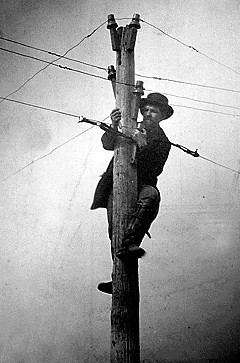Most consider the technological changes of the 19th century more foundational than ours but also slower to proliferate, but the latter wasn’t always so. Consider that the Pony Express was established in 1860 and had been made completely obsolete by telegraphy by 1861, a rush from cradle to grave without the benefit of a dotage. That same year the Civil War began and President Lincoln, an early adopter, was soon sleeping in the telegraph office in the War Department next to the White House. Every era had been an Information Age in one way or another, but some fundamental things had changed and they were speed and connectivity.
In an excellent Newsweek article, journalist Kevin Maney looks back at the mid-19th century technological boom and sees a reflection of our own tumultuous political times. He believes wealth inequality has been stoked by the jolting transition from industrialization to digitalization in much the same as it was in the 1850s when we moved from an agrarian economy to one of factories. The North reached for the future with innovative inventions while the South doubled down on a farm-based economy powered by slavery. Soon enough, the center could not hold.
There’s truth to Maney’s theory, though I think there’s more at play and don’t believe the shocking displays of bigotry and xenophobia we’ve recently witnessed can be wholly explained by our puzzling new economic reality. Such sad things predated AI and apps. As he argues, though, great leadership and policy will be necessary to help us traverse unsure terrain before we can arrive at what may be a post-scarcity society.
The opening:
A technological revolution killed the Whig Party in 1850. A new one is blasting the GOP into splinters in 2016.
Amazingly, none of the presidential candidates talk much about technology, yet our software-eats-the-world whirlwind drives everything that’s cleaving the country and throwing its politics into chaos. The parallels to the dynamics of the 1850s are a little scary. After all, the Whigs’ self-destruction was a prelude to the Civil War.
Like today, the technological revolution in the mid-1800s ushered in a disruptive new era of connectivity, and transportation technology was key. Before the 1800s, getting anywhere—or exchanging any information over distance—involved horses, mud roads or boats. Movement was so hard that almost all business in America stayed local and small, and much of it was centered on agriculture.
Then, starting around 1810, the country paved roads and built canals. Robert Fulton invented the steamboat in 1807, and within a couple of decades mountains of goods were flowing upstream. The monster agent of change was the railroads. The country built rail lines with the same alacrity that would go into building the Web during the dot-com boom. By 1860, the U.S. boasted more miles of rail than the rest of the world combined.
Oh, and in the 1830s Samuel Morse invented the telegraph. By 1860, telegraph lines spanned the continent. You couldn’t quite sit in Boston and Skype your dad at the California Gold Rush, but prices and business data could cross states in a flash. It was an information transformation.
All of this changed life and economics in ways we can relate to today.•
Tags: Kevin Maney

